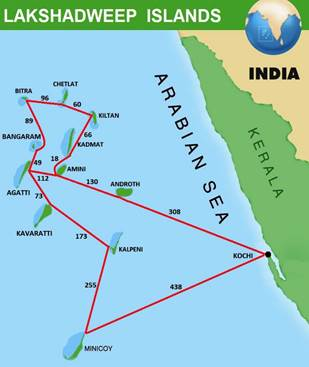Kochi-Lakshadweep Islands Submarine Optical Fiber Connection Project | 08 Jan 2024
For Prelims: KLI-SOFC Project, Digital India, Fibre Optic Cables, National Broadband Mission, Lakshadweep Islands
For Mains: Government Policies & Interventions, Significance of Digital Connectivity Infrastructure
Why in News?
Recently, the Prime Minister of India inaugurated the Kochi-Lakshadweep islands submarine optical fiber connection (KLI-SOFC) project among various developmental projects \covering a wide range of sectors including technology, energy, water resources, healthcare and education.
What are the Key Facts About the KLI-SOFC Project?
- Background:
- Lakshadweep required digital connectivity, prompting a high-capacity submarine cable link due to limitations in satellite communication, marked by inadequate bandwidth to meet growing demand.
- KLI-SOFC Project:
- The KLI-SOFC project will lead to an increase in internet speed, unlocking new possibilities and opportunities.
- The project introduces Submarine Optic Fiber Cable connectivity for the first time in Lakshadweep since independence.
- Fiber optics, or optical fiber, refers to the technology that transmits information as light pulses along a glass or plastic fiber.
- The Department of Telecommunications (DOT) funded by the Universal Services Obligation Fund (USOF), completed the project. Bharat Sanchar Nigam Limited (BSNL) was the Project Executing Agency.
- The KLI project extended submarine cable connectivity from the mainland (Kochi) to eleven Lakshadweep Islands namely, Kavaratti, Agatti, Amini, Kadmat, Chetlet, Kalpeni, Minicoy, Androth, Kiltan, Bangaram and Bitra has been extended.
- Significance:
- The project aligns with the goals of 'Digital India' and 'National Broadband Mission,' fostering the rollout of various e-governance projects in Lakshadweep Islands.
- E-Governance, Tourism, Education, Health, Commerce, and Industries will experience significant enhancements, contributing to improved standards of living and overall socio-economic development on the islands.
- The population of Lakshadweep Islands will benefit from high-speed wireline broadband connectivity, facilitated through Fibre to the Home (FTTH), and 5G/4G Mobile network technologies.
- The bandwidth generated by the project will be accessible to all Telecom Service Providers (TSPs), reinforcing telecom services in Lakshadweep Islands.
- The project aligns with the goals of 'Digital India' and 'National Broadband Mission,' fostering the rollout of various e-governance projects in Lakshadweep Islands.
Other Projects in Lakshadweep Islands
- Low-Temperature Thermal Desalination (LTTD) Plant at Kadmat:
- Produces 1.5 lakh litres of clean drinking water every day. Functional Household Tap Connections (FHTC) in Agatti and Minicoy Islands.
- All households on the Agatti and Minicoy islands now have functional household tap connections.
- The LTTD is a process under which the warm surface seawater is flash evaporated at low pressure and the vapour is condensed with cold deep sea water.
- Produces 1.5 lakh litres of clean drinking water every day. Functional Household Tap Connections (FHTC) in Agatti and Minicoy Islands.
- Solar Power Plant at Kavaratti:
- The first-ever battery-backed solar power project in Lakshadweep.
- Primary Health Care Facility in Kalpeni:
- Foundation stone laid for the renovation of the primary health care facility in Kalpeni.
- Model Anganwadi Centres (Nand Ghars):
- Five model Anganwadi centres (Nand Ghars) to be constructed in the islands of Androth, Chetlat, Kadmat, Agatti, and Minicoy.
What are the Key Facts About the Lakshadweep Islands?
- India’s smallest Union Territory Lakshadweep is an archipelago consisting of 36 islands with an area of 32 sq km.
- The capital is Kavaratti and it is also the principal town of the UT.
- All Islands are 220 to 440 km away from the coastal city of Kochi in Kerala, in the emerald Arabian Sea.
- The name Lakshadweep in Malayalam and Sanskrit means ‘a hundred thousand islands’.
- Lakshadweep has a tropical climate and it has an average temperature of 27° C – 32° C.
- As the climate is equitable during monsoons, ship-based tourism is closed.
- It is directly under the control of the Centre through an administrator.
- The entire indigenous population has been classified as Scheduled Tribes because of their economic and social backwardness.
- According to the Scheduled Castes and Scheduled Tribes list (modification orders), 1956, there are no Scheduled Castes in this Union Territory.
- In 2020, the Lakshadweep Islands administration established the world's first conservation area for sea cucumbers , the Dr. KK Mohammed Koya Sea Cucumber Conservation Reserve, spanning 239 square kilometers in the Cheriyapani Reef.
UPSC Civil Services Examination, Previous Year Question (PYQ)
Q. Where was the first desalination plant in India to produce one lakh litres freshwater per day based on low temperature thermal desalination principle commissioned? (2008)
(a) Kavaratti
(b) Port Blair
(c) Mangalore
(d) Valsad
Ans: (a)
Exp:
- The National Institute of Ocean Technology (NIOT), Chennai has developed the world’s first Low Temperature Thermal Desalination (LTTD) plant in Kavaratti, the capital of Lakshadweep to cater to the requirements of the local population of Karavatti, Minicoy and Agatti.
- The reverse osmosis, a membrane process which is globally accepted technology suitable for desalination of saline water, is quite different from LTTD technology.
- The LTTD is a process under which the warm surface sea water is flash evaporated at low pressure and the vapour is condensed with cold deep sea water.
- The LTTD technology does not require any chemical pre and post-treatment of seawater and thus the pollution problems are minimal and the process is suitable for island territories. Since no effluent treatment is required, it gives less operational maintenance problems compared to other desalination processes.
- Therefore, option (a) is the correct answer.

